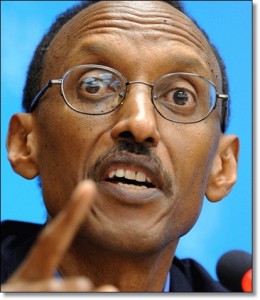Against all odds, after spending more than a billion dollars (U.S.) and employing the intelligence services of the United States, England, Canada, Belgium and Israel, the International Criminal Tribunal for Rwanda (ICTR), has yet to find any physical evidence for their thesis of a central planning of the genocide. This result was quite predictable from the outset. In fact, intelligence gathering was and still is Paul Kagame’s best strength. His agents had infiltrated all spheres of Rwandan society even before October 1990. So, if evidence of planning the Rwandan Genocide by Hutus ever existed, Kagame would have made it available to the ICTR immediately and thus would have definitively silenced sceptics. Despite this void, all the experts remain certain: the killings in 1994 were so systematic that they must have been pre-planned. Then, one must ask, who was the planner? Who was the mastermind? Since investigations on the Rwandan Government’s side have (so far) failed to find any evidence of pre-planning by Hutus, would not be logical to investigate the other warring side, the Rwandan Patriotic Front (RPF)?
Kagame fanned hatred against those deemed Tutsi by committing systematic massacres against the predominantly Hutu population. As it would happen in other countries in similar circumstances, these systematic massacres by Kagame’s men, reputed Tutsi, against the population, mostly Hutu, stirred up hatred against those deemed Tutsis and weakened the moderate political forces which were dominant at the beginning of the war (October 1990-February 1993).
In his testimony, Ruzibiza tells that long before 1994 Kagame had instructed his men who infiltrated within Rwanda, particularly within the Interahamwe (a militia that participated in the genocide of interior Tutsis), to massacre interior Tutsis in such a way that the crimes could be attributed to the government forces and militias.
On April 06, 1994, the plane transporting President Juvenal Habyarimana was shot down by a missile. As could be expected, this terrorist act sparked a human tragedy of unthinkable proportion: the Rwandan Genocide. The investigation of French anti-terrorist judge Jean-Louis Brugui_re concluded that this terrorist crime was commissioned by Paul Kagame. This terrorist assassination was carried out despite the fact that in February 1994, following the assassination of Felicien Gatabazi (leader of the PSD party) and Martin Bucyana (leader of the CDR party), President Habyarimana had demonstrated that he still held ultimate authority and was still capable of maintaining law and order in his country by bringing a halt to the social unrest caused by these murders.
In April 1994, while the interior Tutsis were being massacred, Kagame and his men opposed the intervention of international forces. Charles Muligande, the current Rwandan Minister of Foreign Affairs, was part of the delegation that was sent to the United States to seek support from Washington for this opposition.
Among the founders of the Interahamwe are Anastase Gasana (now exiled in the United States), rewarded with the post of Minister of Foreign Affairs in Kagame’s regime and Desir_ Murenzi, who was placed at the head of a major oil company. Also troubling is the fact that Robert Kajuga, the Tutsi President of the Interahamwe, is the brother of a Rwandan businessman named Husi (killed during the Rwandan Genocide), who, according to several sources, has funded the scholarship of Janet Nyiramongi, Paul Kagame’s wife. These indications point to the fact that the militia Interahamwe was, from beginning to end, manipulated by Kagame’s secret services.
These previous observations demonstrate beyond a reasonable doubt that Paul Kagame has done everything possible to ensure that interior Tutsis were exterminated. Therefore, it has to be concluded, in the words of Kagame himself in his speech delivered on the 10th anniversary of the Rwandan Genocide, that, “Indeed the Rwandan Genocide was premeditated, calculated and cold blooded”. However, in light of these facts, we must now add that the mastermind of the genocide of the Rwandan interior Tutsis is Kagame himself.
Biography: Guillaume Murere
I am of Hutu background and was pursuing a doctorate program in electrical engineering at École Polytechnique de Montréal when the Rwandan war broke out on October 1st, 1990. At the beginning of the war I made a statement in favor of Tutsi refugees and for this reason was labeled by fellow Rwandans as RPF sympathizer and was ostracized and persecuted. In reaction to this persecution, but more in support of Arusha peace negotiations, I openly joined the RPF, Montreal section, in July 1993. I quitted the RPF in April 1995 after I had all evidence that Kagame and the RPF, under Kagame’s strict control, use the genocide of interior Tutsis as a weapon of massive destruction against innocent population, particularly those reputed Hutu. In the unending Rwandan crisis, my worst day was on March 3rd, 1997 when Kagame’s troops shoot down all young men who have passed the night at my father’s home for the mourning of my mother who was put in grave on March 2nd, 1997. On March 3rd, 1997, Kagame’s men killed my two brothers and 8 of my cousins. On that single day, Kagame’s troops killed more than 1000 young Hutus in the outskirts of the city of Ruhengeri.
Having been member of the RPF and close to the Tutsi community and also being of Hutu background, I was in position to see and analyze what was going on either side without bias. Currently I work for peace and reconciliation among Rwandans by uncovering and exposing the truth about the Rwandan crisis…Read more
